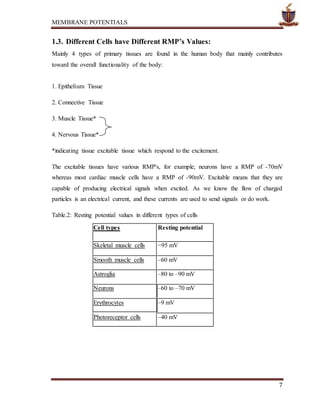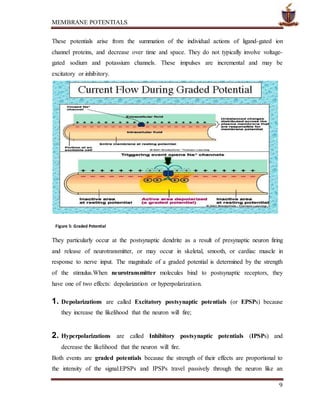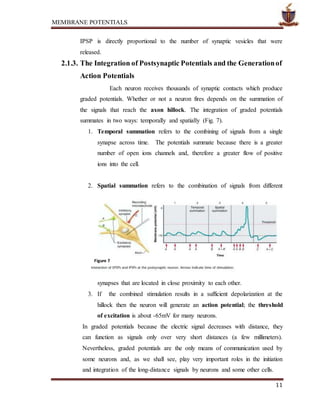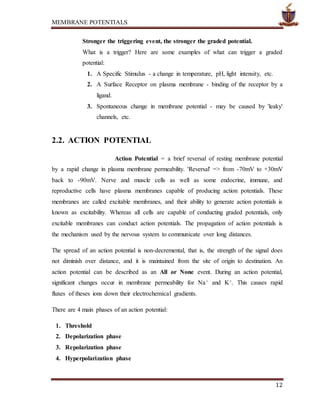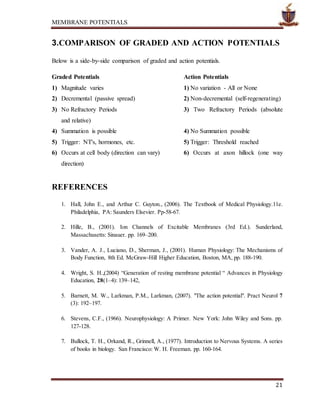The document discusses membrane potentials, including resting membrane potential and graded and action potentials. Resting membrane potential is maintained by ion concentration gradients established by the sodium-potassium pump and differential membrane permeability. It varies between cell types but is around -70 mV for neurons. Graded potentials are caused by neurotransmitters and can summate to reach threshold for an action potential. Action potentials are rapid, regenerative changes in membrane potential triggered by voltage-gated sodium and potassium channels. They propagate along neurons to transmit signals in the nervous system.
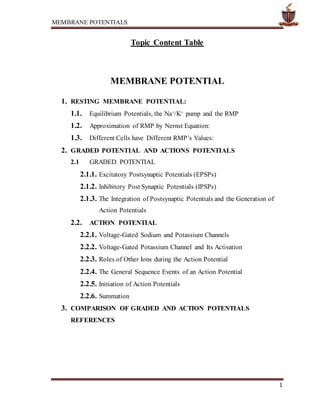
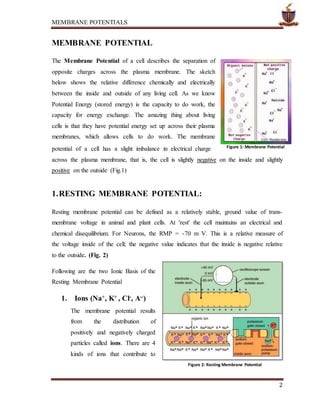



![MEMBRANE POTENTIALS
6
[K+]o is the extracellular concentration of potassium, measured in mol·m−3 or
mmol·l−1
[K+]i is likewise the intracellular concentration of potassium
Potassium equilibrium potentials of around −80 millivolts (inside negative) are common.
Differences are observed in different species, different tissues within the same animal, and
the same tissues under different environmental conditions. Applying the Nernst Equation
above, one may account for these differences by changes in relative K+ concentration or
differences in temperature.
Common usage of the Nernst equation is often given in a simplified form by assuming
typical human body temperature (37 °C), reducing the constants and switching to Log base
10. (The units used for concentration are unimportant as they will cancel out into a ratio).
For Potassium at normal body temperature one may calculate the equilibrium potential in
millivolts as:
Likewise the equilibrium potential for sodium (Na+) at normal human body temperature is
calculated using the same simplified constant. You can calculate E assuming an outside
concentration, [K+]o, of 10mM and an inside concentration, [K+]i, of 100mM. For chloride
ions (Cl−) the sign of the constant must be reversed (−61.54 mV). If calculating the
equilibrium potential for calcium (Ca2+) the 2+ charge halves the simplified constant to
30.77 mV. If working at room temperature, about 21 °C, the calculated constants are
approximately 58 mV for K+ and Na+, −58 mV for Cl− and 29 mV for Ca2+. At
physiological temperature, about 29.5 °C, and physiological concentrations (which vary for
each ion), the calculated potentials are approximately 67 mV for Na+, −90 mV for K+,
−86 mV for Cl− and 123 mV for Ca2+.](https://image.slidesharecdn.com/membranepotentialsfinalformated-160818110201/85/Membrane-potentials-6-320.jpg)
